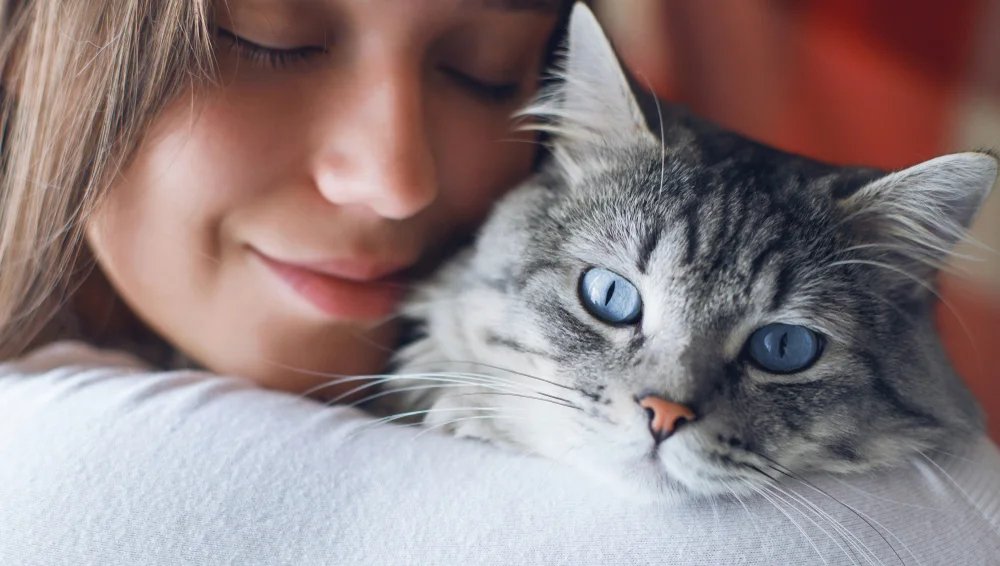
What if your cat is not just a pet, but a living antidepressant? Scientists confirm that behind the purring and soft paws lies a powerful biochemical mechanism that can rebuild the owner’s brain. Cats can influence our nervous system no less than close people. writes Conversation.
The secret lies in oxytocin – “the hormone of trust and affection.” This is the same natural mechanism that evokes warm feelings when hugging a child or meeting a friend.
How cats help
Japanese researchers experimentally proved: A few minutes of stroking the cat is enough for the hormone of love and affection to begin to be released.. During the experiment, women simply petted their pets and spoke gently to them – after a few minutes, the level of oxytocin in their saliva increased significantly. But a quiet holiday without a cat had no such effect.
Research showthat not only stroking, but even The sound of purring can stimulate the release of oxytocin in our brain. Such contact with a catreduces stress levels, calms the nervous system and helps the body recover. Scientists also note a therapeutic effect in the form of lowering blood pressure and reducing pain. In this case, the key condition is the voluntary nature of interaction.
What is the main secret
Фото: beton studio/Shutterstock/FOTODOM
2025 Study revealed An interesting pattern: the level of oxytocin increases in both owners and their pets, but only when communication occurs without coercion. The most noticeable surge of the hormone is observed in cats that initiate contact themselves – jumping on the lap or rubbing against the owner’s legs. The more time the pets spent next to their owners, the stronger the reaction.
However, it has been noted that not every cat and not every contact has a positive effect for humans and animals. For example, there are cats that avoid people and prefer to keep their distance. If you stroke and squeeze them forcefully, the level of oxytocin in animals drops. And there are anxious cats that constantly follow their owner, demanding his attention, but quickly get tired of physical contact. With intrusive communication, their oxytocin levels also decrease.
Cats and dogs – why they are different communication styles
To understand the uniqueness of a cat’s affection, scientists often compare it with a dog’s – the standard of devotion.
The intensity of a dog’s emotions is directly reflected in their biochemistry. IN experimentwhere owners played with their pets for 10 minutes, oxytocin levels in dogs soared by 57%, while in cats they increased by only 12%.
Scientists explain this difference by evolution: dogs, as pack animals, are genetically predisposed to open social behavior, while cats are descendants of lonely hunterswhose restraint is a centuries-old adaptation to independent survival. This is why cat affection requires more patience. “Love Hormone”is allocated to them only in a state of complete safety.
During the pandemic, as owners began to spend more time with their cats, many pets became more affectionatethan before. Some individuals began to follow “their” person much more often and accompany him everywhere.
How does a cat show affection?
Photo: larisa Stefanjuk/Shutterstock/FOTODOM
cats, affection
Unlike dogs, cats do not rely on prolonged eye contact to establish a connection. Instead, they use more subtle signals. The most famous of them is slow blinking: this is a kind of cat smilesignaling safety and trust.
To win over your cat, you need to blink slowly, squinting your eyes. This found out in 2020, scientists from the Universities of Sussex and Portsmouth during experiments. It turned out that animals perceive this signal in the same way as people react to a smile. Even an unfamiliar cat can approach a person if he blinks correctly.
Purring also plays a prominent role in bonding with people. After analyzing the DNA and behavior of 280 domestic cats, Japanese scientists came to conclusionthat special vocalizations are a developed strategy for attracting attention and support, which helps survival both among other cats and in communication with people. Interestingly, the androgen receptor gene mutation occurs only in domestic cats, and not in their wild relatives. This means that the mutation arose after domestication.
Scientists note that interacting with a cat can help prevent anxiety and depression, and in some cases it provides comfort comparable to human social support.
When you can’t get the cat off your lap, even if it’s getting in the way of your work and errands, you may be wiser than you think: How can you interrupt a natural therapy session that you both so desperately need?
Disclaimer: This news article has been republished exactly as it appeared on its original source, without any modification.
We do not take any responsibility for its content, which remains solely the responsibility of the original publisher.
Disclaimer: This news article has been republished exactly as it appeared on its original source, without any modification.
We do not take any responsibility for its content, which remains solely the responsibility of the original publisher.
Author: uaetodaynews
Published on: 2025-10-25 08:08:00
Source: uaetodaynews.com
